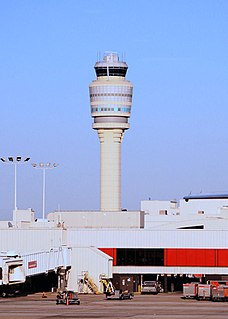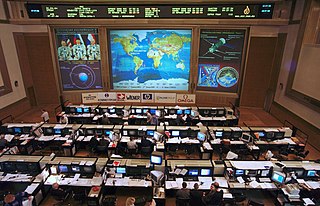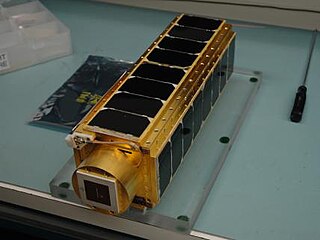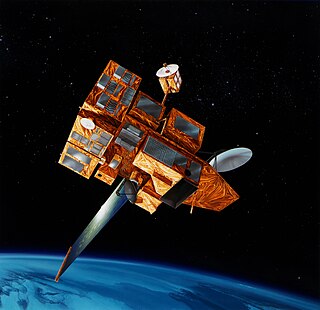Related Research Articles

The European Space Operations Centre (ESOC) serves as the main mission control centre for the European Space Agency (ESA) and is located in Darmstadt, Germany. ESOC's primary function is the operation of unmanned spacecraft on behalf of ESA and the launch and early orbit phases (LEOP) of ESA and third-party missions. The Centre is also responsible for a range of operations-related activities within ESA and in cooperation with ESA's industry and international partners, including ground systems engineering, software development, flight dynamics and navigation, development of mission control tools and techniques and space debris studies.

Air traffic control (ATC) is a service provided by ground-based air traffic controllers who direct aircraft on the ground and through controlled airspace, and can provide advisory services to aircraft in non-controlled airspace. The primary purpose of ATC worldwide is to prevent collisions, organize and expedite the flow of air traffic, and provide information and other support for pilots. In some countries, ATC plays a security or defensive role, or is operated by the military.
High-Level Data Link Control (HDLC) is a bit-oriented code-transparent synchronous data link layer protocol developed by the International Organization for Standardization (ISO). The standard for HDLC is ISO/IEC 13239:2002.

In IEEE 802 LAN/MAN standards, the medium access control sublayer is the layer that controls the hardware responsible for interaction with the wired, optical or wireless transmission medium. The MAC sublayer and the logical link control (LLC) sublayer together make up the data link layer. Within the data link layer, the LLC provides flow control and multiplexing for the logical link, while the MAC provides flow control and multiplexing for the transmission medium.
Synchronous Data Link Control (SDLC) is a computer communications protocol. It is the layer 2 protocol for IBM's Systems Network Architecture (SNA). SDLC supports multipoint links as well as error correction. It also runs under the assumption that an SNA header is present after the SDLC header. SDLC was mainly used by IBM mainframe and midrange systems; however, implementations exist on many platforms from many vendors. The use of SDLC is becoming more and more rare, mostly replaced by IP-based protocols or being tunneled through IP. In the United States, SDLC can be found in traffic control cabinets.

The Tracking and Data Relay Satellite System (TDRSS) is a network of American communications satellites and ground stations used by NASA for space communications. The system was designed to replace an existing network of ground stations that had supported all of NASA's manned flight missions. The prime design goal was to increase the time spacecraft were in communication with the ground and improve the amount of data that could be transferred. Many Tracking and Data Relay Satellites were launched in the 1980s and 1990s with the Space Shuttle and made use of the Inertial Upper Stage, a two-stage solid rocket booster developed for the shuttle. Other TDRS were launched by Atlas IIa and Atlas V rockets.

Milstar is a constellation of military communications satellites in geosynchronous orbit, which are operated by the United States Air Force, and provide secure and jam-resistant worldwide communications to meet the requirements of the Armed Forces of the United States. Six spacecraft were launched between 1994 and 2003, of which five are currently operational; the third launch failed, both damaging the satellite and leaving it in an unusable orbit.
A remote base station is a common name for an amateur radio auxiliary station that is controlled and operated from a remote location. Most remote base stations have similar features to any other Amateur radio station but can be controlled over a direct wired connection or the internet, or by radio.
A systems integrator is a person or company that specializes in bringing together component subsystems into a whole and ensuring that those subsystems function together, a practice known as system integration. They also solve problems of automation. Systems integrators may work in many fields but the term is generally used in the information technology (IT) field such as computer networking, the defense industry, the mass media, enterprise application integration, business process management or manual computer programming. Data quality issues are an important part of the work of systems integrators.

Paul Sean Hill was the Director of Mission Operations at the NASA Lyndon B. Johnson Space Center in Houston, Texas. He was formerly a Flight Director in the Mission Control Center for Space Shuttle and International Space Station missions under the call sign "Atlas".

Flight controllers are personnel who aid space flight by working in such Mission Control Centers as NASA's Mission Control Center or ESA's European Space Operations Centre. Flight controllers work at computer consoles and use telemetry to monitor various technical aspects of a space mission in real time. Each controller is an expert in a specific area and constantly communicates with additional experts in the "back room". The flight director, who leads the flight controllers, monitors the activities of a team of flight controllers, and has overall responsibility for success and safety.
The Link Layer Discovery Protocol (LLDP) is a vendor-neutral link layer protocol used by network devices for advertising their identity, capabilities, and neighbors on a local area network based on IEEE 802 technology, principally wired Ethernet. The protocol is formally referred to by the IEEE as Station and Media Access Control Connectivity Discovery specified in IEEE 802.1AB and IEEE 802.3 section 6 clause 79.
The Grand Ducal Police is the national police service in the Grand Duchy of Luxembourg. The police is under the control of the Minister for the Interior of Luxembourg, although they operate in the name, and under the ultimate control, of the Grand Duke of Luxembourg. Day-to-day executive control is exercised by the Director-General of the Grand Ducal Police. The Grand Ducal Police has existed in its current form since 1 January 2000, when the Grand Ducal Gendarmerie was merged with the police service.

The Columbus Control Centre also known by its radio callsign, Mission Control Munich, is the Mission Control Center which is used to control the European Columbus research laboratory, which is part of the International Space Station (ISS). The control centre is located at the German Aerospace Center (DLR) facility in Oberpfaffenhofen near Munich, Germany. The centre is operated by the DLR, under contract from the European Space Agency (ESA).
IEC 60870 part 6 is one of the IEC 60870 set of standards which define systems used for telecontrol in electrical engineering and power system automation applications. The IEC Technical Committee 57 have developed part 6 to provide a communication profile for sending basic telecontrol messages between two systems which is compatible with ISO standards and ITU-T recommendations.

PharmaSat was a nanosatellite developed by NASA Ames Research Center which measured the influence of microgravity upon yeast resistance to an antifungal agent. As a follow on to the GeneSat-1 mission, the Ames Small Spacecraft Division conducted the PharmaSat mission in collaboration with industry and local universities.

ADEOS II was an Earth observation satellite launched by NASDA, with contributions from NASA and CNES, in December 2002. Its Japanese name was Midori 2, and it was the successor to the 1996 mission ADEOS I. The mission ended in October 2003 after the satellite's solar panels failed.
An Internet Remote Base (IRB) is a ham radio remote base station controlled via an internetwork such as the Internet. IRBs are used to provide time-shared access to control radio transceivers or receivers, notably for use by licensed Amateur Radio operators.

A ground segment consists of all the ground-based elements of a spacecraft system used by operators and support personnel, as opposed to the space segment and user segment. The ground segment enables management of a spacecraft, and distribution of payload data and telemetry among interested parties on the ground. The primary elements of a ground segment are:
Social Networks and Archival Context (SNAC) is an online project for discovering, locating, and using distributed historical records in regard to individual people, families, and organizations.
References
![]()
| This computer networking article is a stub. You can help Wikipedia by expanding it. |